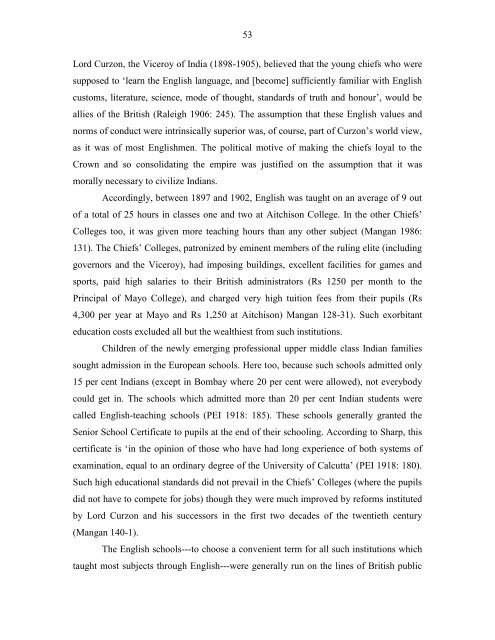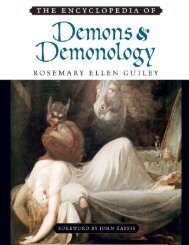DENIZENS OF ALIEN WORLDS
danizen1
danizen1
- No tags were found...
Create successful ePaper yourself
Turn your PDF publications into a flip-book with our unique Google optimized e-Paper software.
53<br />
Lord Curzon, the Viceroy of India (1898-1905), believed that the young chiefs who were<br />
supposed to ‗learn the English language, and [become] sufficiently familiar with English<br />
customs, literature, science, mode of thought, standards of truth and honour‘, would be<br />
allies of the British (Raleigh 1906: 245). The assumption that these English values and<br />
norms of conduct were intrinsically superior was, of course, part of Curzon‘s world view,<br />
as it was of most Englishmen. The political motive of making the chiefs loyal to the<br />
Crown and so consolidating the empire was justified on the assumption that it was<br />
morally necessary to civilize Indians.<br />
Accordingly, between 1897 and 1902, English was taught on an average of 9 out<br />
of a total of 25 hours in classes one and two at Aitchison College. In the other Chiefs‘<br />
Colleges too, it was given more teaching hours than any other subject (Mangan 1986:<br />
131). The Chiefs‘ Colleges, patronized by eminent members of the ruling elite (including<br />
governors and the Viceroy), had imposing buildings, excellent facilities for games and<br />
sports, paid high salaries to their British administrators (Rs 1250 per month to the<br />
Principal of Mayo College), and charged very high tuition fees from their pupils (Rs<br />
4,300 per year at Mayo and Rs 1,250 at Aitchison) Mangan 128-31). Such exorbitant<br />
education costs excluded all but the wealthiest from such institutions.<br />
Children of the newly emerging professional upper middle class Indian families<br />
sought admission in the European schools. Here too, because such schools admitted only<br />
15 per cent Indians (except in Bombay where 20 per cent were allowed), not everybody<br />
could get in. The schools which admitted more than 20 per cent Indian students were<br />
called English-teaching schools (PEI 1918: 185). These schools generally granted the<br />
Senior School Certificate to pupils at the end of their schooling. According to Sharp, this<br />
certificate is ‗in the opinion of those who have had long experience of both systems of<br />
examination, equal to an ordinary degree of the University of Calcutta‘ (PEI 1918: 180).<br />
Such high educational standards did not prevail in the Chiefs‘ Colleges (where the pupils<br />
did not have to compete for jobs) though they were much improved by reforms instituted<br />
by Lord Curzon and his successors in the first two decades of the twentieth century<br />
(Mangan 140-1).<br />
The English schools---to choose a convenient term for all such institutions which<br />
taught most subjects through English---were generally run on the lines of British public












